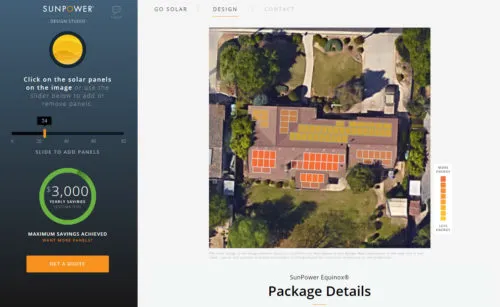SunPower’s new Design Studio uses machine learning to design residential solar projects in seconds
Sep 9, 2019 09:03 PM ET

SunPower has launched a web application that can design rooftop solar projects in seconds. SunPower’s Design Studio combines SunPowers’s Instant Design technology, Google Cloud and Google Sunroof to deliver customizable residential solar designs that take into account roof size, shading and energy potential. Homeowners can modify their design based on their energy needs, resulting in more accurate predictions of electricity bill and energy savings.
“With SunPower Design Studio, we’ve created a new solar buying experience,” said Jake Wachman, digital VP for SunPower. “We’re making solar accessible by enabling homeowners nationwide to envision solar on their home and understand savings at lightning-fast speeds. With SunPower Design Studio, we’re changing how homeowners go solar.”
From a mobile phone or computer, homeowners enter their address and estimated monthly electric bill into the SunPower Design Studio web app. The application then presents a customized SunPower Equinox solar design, including panels, a battery and energy production estimates
Homeowners have the freedom to change the number of SunPower panels on their roof, guided by a color code that identifies which panels will receive the most sun and therefore provide the most energy. As the homeowner adds panels – if anticipating an electric vehicle purchase in the future, for example – or removes them to meet current energy needs, projected energy production and potential electricity bill savings update in real time.
SunPower Design Studio is powered by the company’s proprietary Instant Design technology. Instant Design uses machine learning and high-resolution imagery to design solar power systems for residential roofs in seconds. After entering an address, SunPower machine learning algorithms draw the home’s roof, detect obstructions such as skylights and vents, and determine solar exposure for every point on the roof. The software automatically places SunPower solar panels according to local construction code.
As with other SunPower-developed software, the company will release Design Studio to select dealers to enable greater marketing reach, improve homeowner understanding of solar, and shorten sales cycles. As the application learns with each new design, SunPower also expects to reduce system design costs compared to manual methods.
While the United States has surpassed 2 million solar installations (according to SEIA), only 2% of eligible homeowners have installed solar. There are roughly 100 million future solar homeowners in the United States.
“At the current rate, we would need a century to create designs manually for all American homeowners who don’t yet have solar,” Wachman said. “With SunPower Design Studio, we have the capability to deliver thousands of customized solar roof designs quickly, direct to the homeowner, drastically simplifying the solar experience, and encouraging more consumers to explore solar as a reliable, cost-effective energy option.”
Also read

